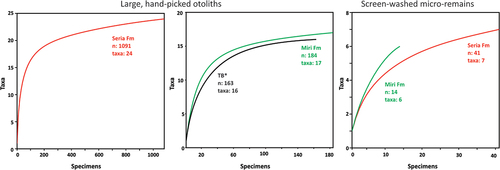Figures & data
Figure 1. Geographic and geological positions of the localities that yielded the reported otoliths. Note that the depositional age of the outcrops gets younger from east to west. Miri Formation sites: Dad – Dadap, Tag – Tagap, JT1 – Tanjong Nangka, JT2 – Jalan Tutong 2, IB – Ikas Bandung, Mar – Maraburong; Seria Formation sites: PB – Pak Bidang; Ker – Keriam; AH – Ambug Hill, JBP – Jalan Pak Bidang. Reworked specimens were also discovered on Tutong beach (TB*).

Table 1. Geographical and geological information on the sampled localities. Note that at the locality of Tanjong Nangka (JT-1), three clay levels yielded fish remains and when it is known for the given specimen, it is referred to in the inventory as JT1-L1, -L2 and -L3, respectively.
Figure 2. Congride and Engraulidae. a-c: Ariosoma sp. from AH (a: NHMUK PV P 76628, b-c: GUBD V0172), inner views; d-e: Setipinna cf. retusa from IB (NHMUK PV P 76629), inner and external views; f-g: Setipinna sp. two specimens from Dad (GUBD V0174) inner views; h-m: Coilia planata (NHMUK PV P 76630) from Dad, posterior (f), inner (g), anterior (h), external (i), ventral (j) and dorsal (k) views; n-q: C. planata inner views of specimens from Dad n & o (NHMUK PV P 76631-32), p: IB (GUBD V0175) and q: Ker (GUBD V0176); r-s: C. planata juvenile specimen from JT1-L2, inner and external views (NHMUK PV P 76633); t-u: Coilia cf. mystus from Ker (NHMUK PV P 76634). Scale bars: 0.5 mm.
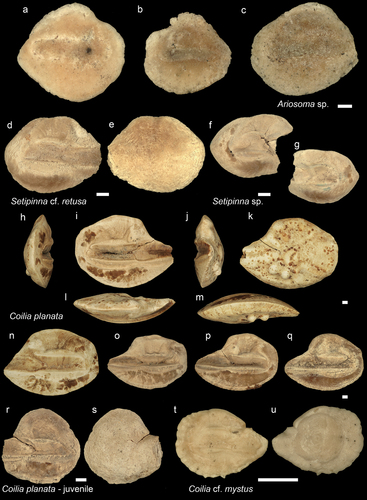
Figure 3. Ariidae. a-d: Ariidae indet. 1 from AH (GUBD V0125); e-h: Ariidae indet. 2 from JT-1 (GUBD V0141); i-l: Ariidae indet. 3 from AH (GUBD V0130); m-p: Ariidae indet. 4 from JT-1 (GUBD V0143). Orientations: ventral (a-b, e-f, i-j, m-n), dorsal (b, f, j, n), and mesial (d, h, l, p) views. Note that the drawings (a, e, i, m) are emphasizing the differences among the distinguished morpho-groups. Scale bar: 5 mm. Abbreviations: Amp - anteromesial projection, Lb - linea basalis.
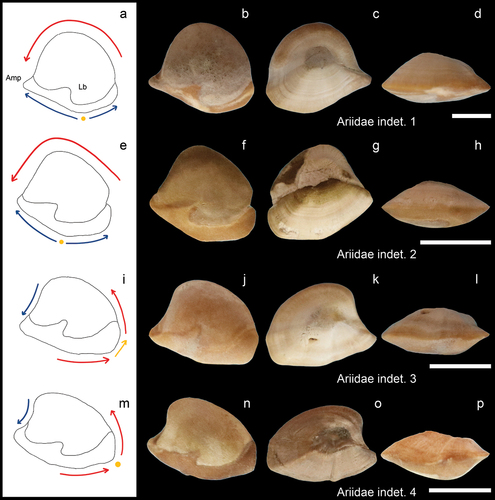
Figure 4. Bregmacerotidae, Apogonidae, and Gobiidae. a-b: Bregmaceros sp. from AH (GUBD V0182) and from IB (NHMUK PV P 76635), inner views; c-h: Apogonidae indet. from AH, c-f (GUBD V0184), inner (c), external (d), ventral (e) and inner dorsal (f) views; g (GUBD V0185) and h (GUBD V0186), inner views; i-n: Gobiidae indet. inner views i-l (GUBD V0187) & n (GUBD V0188) from AH and m from IB (GUBD V0191). Scale bar: 0.1 mm except the big Apogonidae (c-e) which is 0.5mm. The a, g, h, i-l, & n are SEM images.
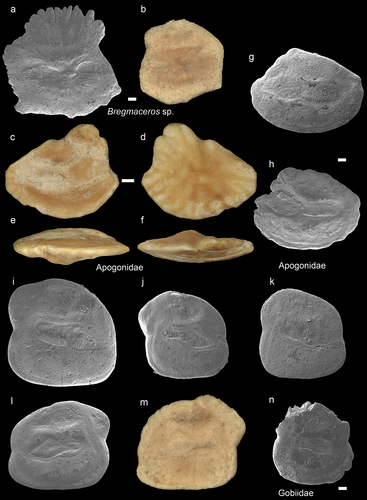
Figure 5. Lactariidae. a-g: Lactarius lactarius fossil specimens from AH. a-d (NHMUK PV P 76636), inner (a), external (b), dorsal (c), and ventral (d) views; e-f inner views of NHMUK PV P 76637 PV P 76638; g – SEM image of a juvenile specimen (GUBD V0194). h-k: modern Lactarius lactarius left and right otoliths BRUJM-20201218-1 BRUJM-20201218-3, TL: 18.5 and 14 cm). Scale bar: 1mm, except 0.1 mm for g.
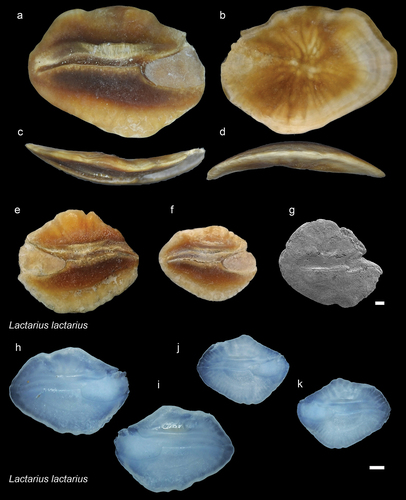
Figure 6. Sciaenidae. a-f: Advenasciaena bruneiana holotype (NHMUK PV P 76639) from JT1 site’s L2 major clay layer: inner (a), external (b), anterior (c), dorsal (d), ventral (e) and posterior (f) views. g-l: A. bruneiana paratype (ASIZF 0100316) from JT1 site’s L2 major clay layer: inner (g), external (h), anterior (i), dorsal (j), ventral (k) and posterior (l) views. m-r: A. bruneiana paratype (RGM.1364031) from Dadap site: anterior (m), inner (n), posterior (o), external (p), ventral (q), dorsal (r) views. Scale bar 1 mm.
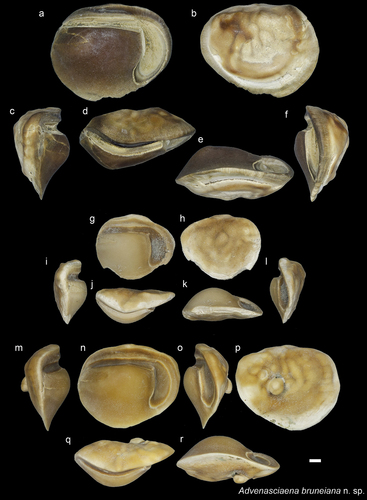
Figure 7. Sciaenidae. a-f: Atrobucca borneensis holotype from AH (NHMUK PV P 76640), posterior (a), inner (b), anterior (c), external (d), dorsal (e) and ventral views (f); g-h: A. borneensis paratype from AH (NHMUK PV P 76641), inner and external views; i-k: A. borneensis from AH inner views of selected size range (NHMUK PV P 766342-44); l-p: Atrobucca aff. borneensis from AH (GUBD V0198), l-n specimen 1: inner (l), dorsal (m) and external (n) views; o-p specimen 2: inner (o) and external (p) views. Scale bar: 1 mm.
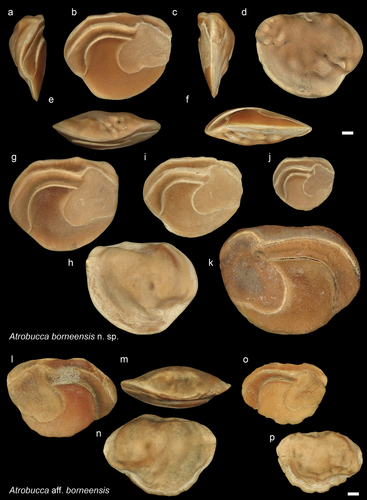
Figure 8. Sciaenidae. a-f: Boesemania obesa from Dad (NHMUK PV P 76645), inner (a), external (b), postrior (c), dorsal (d), anterior (e), ventral (f) views; g: B. obesa from AH inner view (GUBD V0199); h: B. obesa from JT1 inner view (GUBD V0200); i: Boesemania microlepis extant species from Vietnam (GSCN3846). Scale bar: 1mm.
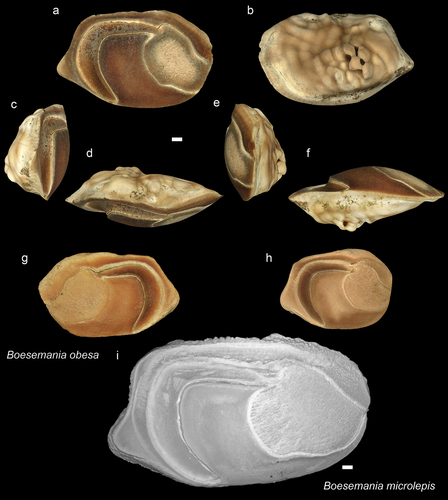
Figure 9. Sciaenidae. a-f: Bruneisciaena schwarzhansi holotype (NHMUK PV P 76646 from Dadap village: posterior (a), inner (b), anterior (c), external (d), dorsal (e), ventral (f) views. g-i: B. schwarzhansi from Dadap paratype (ASIZF 010031): inner (g), dorsal (h), ventral (i) views; j-m: B. schwarzhansi paratype (RGM.1364030) from Bukit Panggal: inner (j), anterior (k), posterior (l), ventral (m) views. n-s: B. schwarzhansi specimens, all with inner view from the type locality of Dadap village (n-p: NHMUK PV P 76647-49 r-s: GUBD V0161). Scale bar 1 mm.
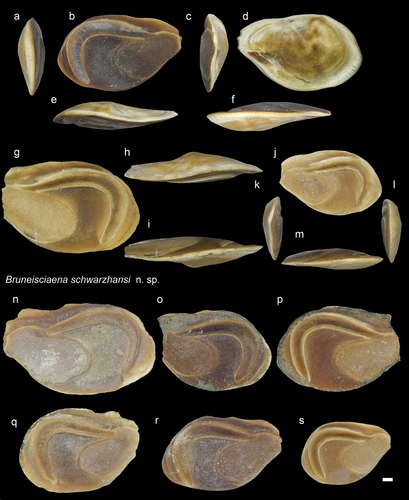
Figure 10. Sciaenidae. a-f: Larimichthys polyactis from AH, inner (a), external (b), posterior (c), dorsal (d), anterior (e), ventral (f) views (NHMUK PV P 76650); g-j: L. polyactis from AH all in inner views (NHMUK PV P 76651-54). Scale bar: 1 mm.
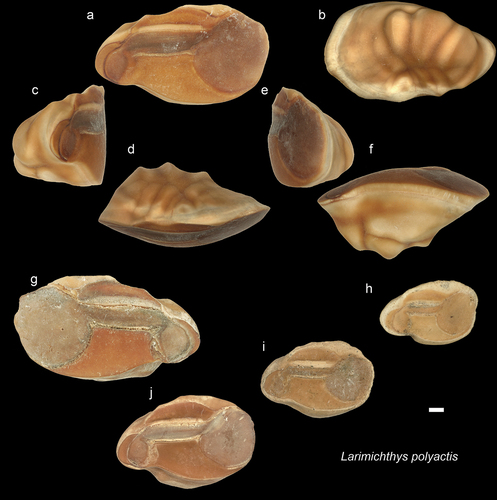
Figure 11. Sciaenidae. a-f: Dendrophysa angulata from AH, posterior (a), inner (b), anterior (c), external (d), dorsal (e) and ventral (f) views (NHMUK PV P 76655); g-n: D. angulata specimens from AH in inner views (g-j: NHMUK PV P 76656-59 k-n: GUBD V0207); o-p: D. angulata from Ker (GUBD V0208 – 2 specimens), inner views. Note the different preservation states. q-r: D. angulata from the Miri Formation all are in inner views q – JT2 (NHMUK PV P 76660), r – JT1-L2 (NHMUK PV P 76661). s-t: Dendrophysa russelii – modern species from Brunei (GSCN4049 TL: 12 cm GSCN4050 TL: 12.9 cm). u-z: Dendrophysa sp. from Ker, posterior (u), inner (v), anterior (w), external (x), dorsal (y) and ventral (z) views; aa-ab: Dendrophysa sp. from Ker and IB, respectively. (u-z aa: NHMUK PV P 76662-63, ab: GUBD V0216). Scale bar: 1 mm.
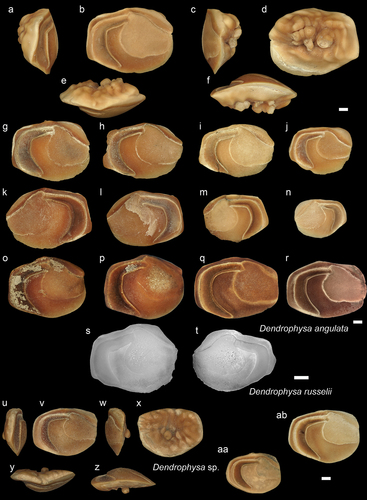
Figure 12. Sciaenidae. a-f: Nibea ambugensis from AH (holotype - NHMUK PV P 76664), posterior (a), inner (b), anterior (c), external (d), dorsal (e) and ventral (f) views; g-q: N. ambugensis specimens from different sizes and localities in inner views. g - from JPB (GUBD V0219), i – from Ker (GUBD V0220), l – Dad (GUBD V0221), h, j, k, m-q from AH (NHMUK PV P 76665-72); r-z: Nibea cf. soldado from AH, specimen-1: anterior (r), inner (s), posterior (t), external (u), dorsal (v) and ventral (w) views (NHMUK PV P 76673), specimen 2: anterior (y) and dorsal (x) views (NHMUK PV P 76674), specimen 3 inner (z) view (NHMUK PV P 76675), aa: Nibea cf. soldado from Ker (GUBD V0224); ab-ac: Nibea soldado modern specimen from Brunei (GSCN4051, TL: 19.7cm and GSCN4053, TL:20.6 cm), inner view. Scale bar: 1mm.
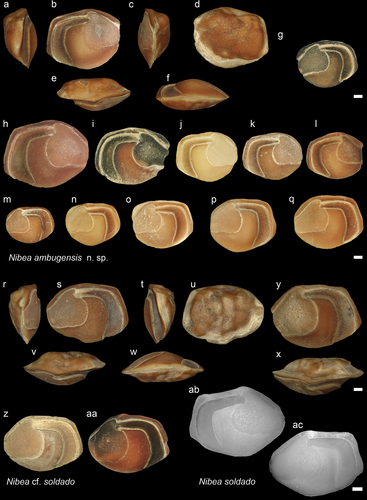
Figure 13. Sciaenidae. a-f: Nibea stintoni holotype from IB (NHMUK PV P 76676), posterior (a), inner (b), anterior (c), external (d), dorsal (e), and ventral (f) views; g-h: N. stintoni from JT1 (GUBD V0227) inner views; i: N. stintoni from AH (GUBD V0228). j-o: Nibea aff. chaoi from Dad, Miri Formation, anterior (j), inner (k), posterior (l), external (M), dorsal (n) and ventral (o) views (NHMUK PV P 76677); p-s: Nibea aff. chaoi from the Miri Formation, inner views, p s from Dad (NHMUK PV P 766778-79), and q & r from JT1 (GUBD V0230). Scale bar: 1 mm.
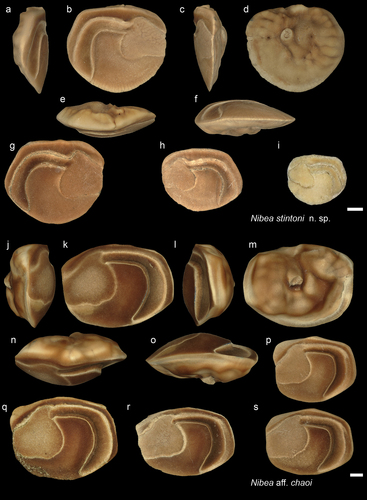
Figure 14. Sciaenidae. a-f: Protonibea nolfi from Tag Miri Formation (holotype - NHMUK PV P 76680), inner (a), external (b), anterior (c), posterior (d), dorsal (e), and ventral (f) views; g-j: P. nolfi two specimens from Dad (NHMUK PV P 76681-82), inner (g i) and dorsal (h j) views; k-m: P. nolfi two paratypes from AH, specimen 1 in inner (k) and dorsal (l) views (NHMUK PV P 76683), specimen 2 in inner view (m) (NHMUK PV P 76684); n: P. nolfi from Ker (GUBD V0233) in inner view. o-q: Protonibea sp. from AH (GUBD V0238); r-t: Protonibea diacanthus modern specimens from Taiwan and Brunei (r: CHLOL4622, TL: 53.5 cm, s: CHLOL5223, TL: 27.6 cm, and t: BRUGM-20220522- TL: 80 cm). Scale bar: 1 mm.
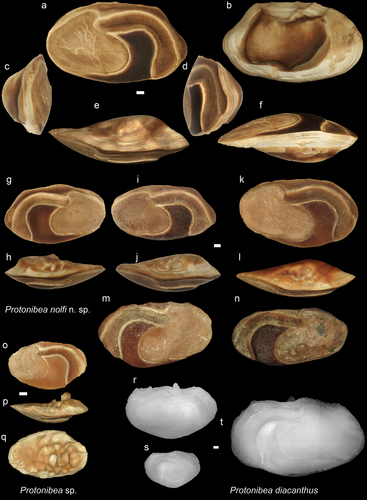
Figure 15. Sciaenidae. a-b: Otolithoides biauritus from AH (NHMUK PV P 76685), inner (a) and dorsal (b) views; c-f: Pterotolithus lateoides from AH, inner (c), external (d), dorsal (e), and ventral (f) views (NHMUK PV P 76686); c-f: P. lateoides from AH, inner (g), dorsal (h), ventral (i), and external (j) views (NHMUK PV P 76687). Scale bar: 1mm.
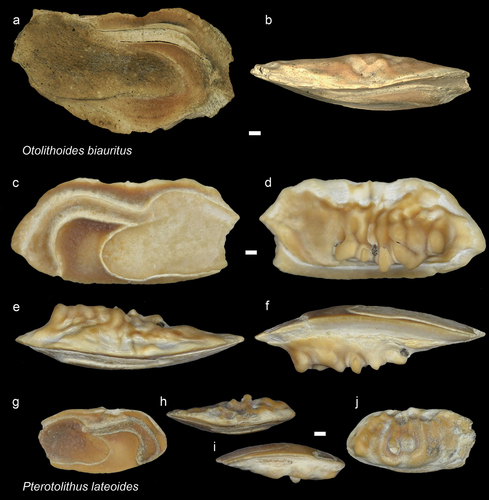
Figure 16. Sillaginidae, Haemulidae, and Cepolidae. a-f: Sillago sp. from AH (NHMUK PV P 76688) posterior (a), inner (b), anterior (c), external (d), dorsal (e), and ventral (f) views; g-h: Sillago sp. from Dad (NHMUK PV P 76689) inner (g) and dorsal (h) views; i-n: Pomadasys sp. from AH anterior (i), inner (j), posterior (k), external (l), dorsal (m), and ventral (n) views; o-r: Pomadasys sp. specimens in different sizes from AH inner views. All the figured Pomadasys are under NHMUK PV P 76690-94; s-u: Acanthocepola sp. from Dad (NHMUK PV P 76695). Scale bars: 1 mm.
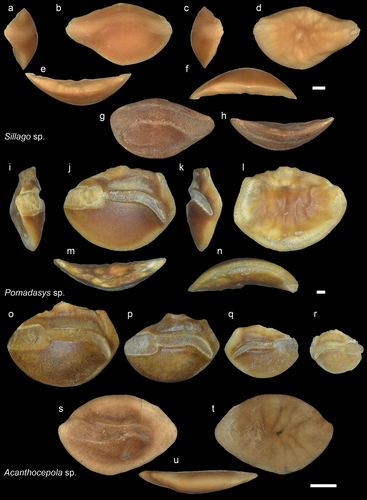
Table 2. Fauna list of the investigated outcrops and their combined numbers for the Miri Formation, Seria Formation, and the reworked assemblage of the Tutong beach.
Figure 17. Abundances graphs with biodiversity information. a: Abundance chart of the large, hand-picked otoliths from the three investigated origins (Seria Formation, Miri Formation, and reworked fauna of Tutong beach – TB*). Pie-chart on the combined fauna show the relative percentages of the recovered fish families. b: Abundance chart of the screen-washed micro-remains (Seria Fm, Miri Fm). Pie-chart on the combined micro-fauna showing relative percentages of the recovered fish families. Note the colour code that corresponds to three faunas on graph (red – Seria Fm, green – Miri Fm, black – reworked fauna TB*). Note that the family Engraulidae appears in both graphs, and the single, common species of Coilia planata represents them among the large otoliths.
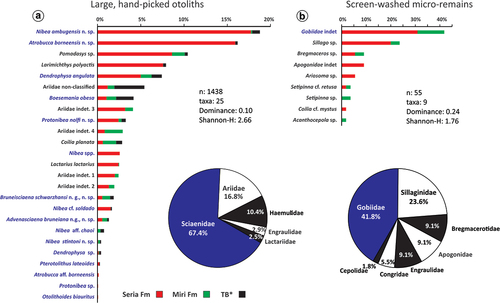
Table 3. Environment and habitat conditions of the recorded taxa based on modern representatives. Most of the data is derived from Nelson et al. (Citation2016) and Froese and Pauly (Citation2022)
Figure 18. Rarefaction curves. Note that the curves of the large otoliths level out, while the micro-remains one is undersaturated. The latter indicates that with collecting more otoliths, additional taxa can be expected.
